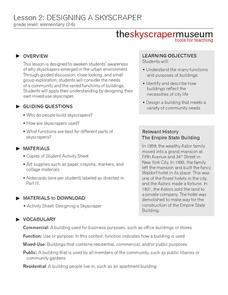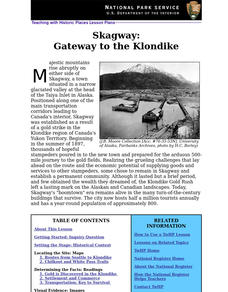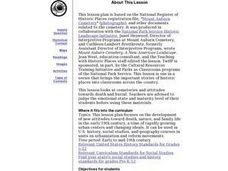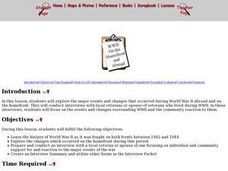Skyscraper Museum
Designing a Skyscraper
Besides serving as awe-inspiring monuments of human achievement, skyscrapers are built to perform a wide range of functions in urban communities. The second lesson plan in this series begins by exploring the history of the Empire State...
Curated OER
Boston's Arnold Arboretum
Students examine how 19th-century urban conditions influenced the development of parks. They research local trees and shrubs, develop a display of trees and shrubs, plan a new park or arboretum, and write a report on a local park.
Curated OER
Orphan Trains
Pupils use readings and discussion to investigate the 19th century practice of Orphan Trains - sending U.S. urban orphans from the East to the Midwest in hopes of procuring them a home. They focus on the concept of social trade-offs.
Curated OER
To Move or Not to Move? Decision Making and Sacrifice
Students examine the motivations that prompted people to move westward during the 19th century. They take on the role of an average citizen and weigh the costs and benefits of making such a move and decide if they would have participated...
Curated OER
Skagway: Gateway to the Klondike
Students explore the impact of the Klondike Gold Rush on the development of Skagway, Alaska. Lesson can be used in units on western expansion, late 19th and early 20th-century commerce, and urban history.
Stanford University
Jacob Riis
Fourth graders view and discuss the photographs of Jacob Riis.In this Jacob Riis and Immigrants instructional activity, 4th graders analyze the photographs of Jacob Riis and answer questions about the feelings evoked by the photographs....
Curated OER
Boston Park System
Students complete a variety of activities that go along with the study of and possible fieldtrip to the Emerald Necklace park system in Boston, MA. They discover how urban conditions influenced the creation of city parks.
Stanford University
Anti-Suffragists
Students view the movie Iron Jawed Suffragists.In this anti- suffragists lesson, students recognize that many people didn't want women's suffrage. Students view documents written about suffrage and create a graphic organizer.
Curated OER
Savannah, Georgia Historic District
Students complete a variety of activities that go along with the study of and possible fieldtrip to the Savannah, Georgia Historic District.
Curated OER
Too Bright at Night?
Students explore the consequences of light pollution. They consider benefits and drawbacks of technology in order to acquire informed attitudes on the various technologies and their social, cultural, economic, and ecological consequences. .
Curated OER
Mount Auburn Cemetery
Students use photos, maps and reading materials to examine the history and role of Mount Auburn Cemetery. They analyze the landscape of the cemetery, consider how it affects visitor's emotions and feelings and then design an original...
Curated OER
The Great Migration: Two American Tales
Young scholars compare and contrast experiences of European immigrants and African American migrants in U.S. cities. After examining the topic, they write essays evaluating the differences and similarities of the groups' experiences.
Curated OER
World War II: Bombs and Peace
Students explore the final events and end of World War II. They examine the community impact of such events as the dropping of the dropping of atomic bombs, and President Roosevelt's death. Students prepare a presentation.
Curated OER
WWII: On The Homefront and Abroad
Students explore World War II from the perspective of both the sides. They research the changes that occurred on the homefront during 1942-1944. Students prepare and conduct an interview with a local veteran or spouse of a veteran...















